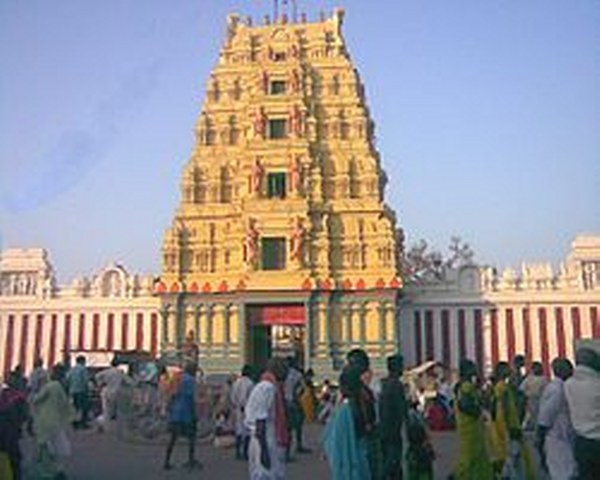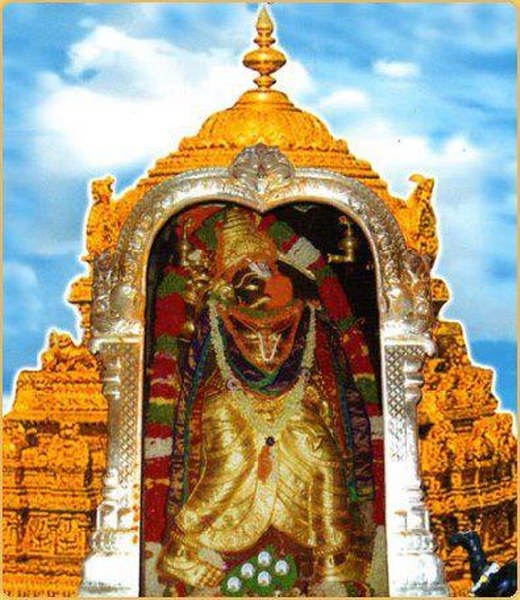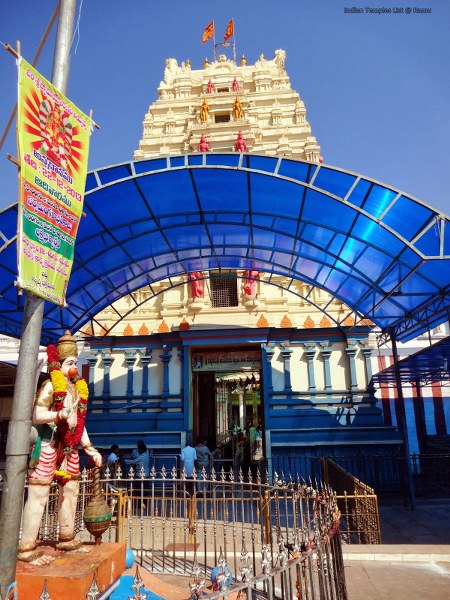 Vijaya Nagara Samrajya and Sri Vyasaraya
Vijaya Nagara Samrajya and Sri Vyasaraya
During sixteenth and seventeenth century many part of south of India was ruled by the Vijayanagar kingdom. Sri Krishnadevaraya, the emperor of Vijayanagara samrajya during 1509-1530 had brought many area under the kingdom. His period of rule is known as golden era of the Vijayanagar kingdom. He had established many welfare measures for his subjects, and also established many temples. During his rule Sri Vyasaraya, follower of Madhva dwaitha was his Raja Guru. Sri Vyasaraya had saved the king Krishnadevaraya from death. To ward off the evil period of the Emperor Rajaguru himself assumed the role of Emperor for four Nazikai (one hour and thirty six minutes). Since then he is known as Sri Vyasa Raja. He had been the Raja guru for many Emperors of Vijayanagara. An adorent devotee of Sri Hanuman Sri Vyasaraja it is said he had established 732 temples for Sri Hanuman.
In the rule of Sri Krishna Devaraya to the Vijayanagaram Kingdom his Guru Sri Vyasarayaluvaru went on tour to attain religious austerities. While he was on tour, he stayed at Village called “Silpagiri” now called as “Chippagiri” Lord Sri Anjaneya Swamy appeared before Sri Vyasaraya in his dream and advised him to consecrate his idol at place, where the dried Margosa stick will emerge as live tree. Accordingly, Sri Vyasarayalu Varu made prathista of Sri Anjaneya Swamy idol (Swayambhu)at a place called Nettikallu where he saw the dried margosa stick emerged as a live tree and have the deity is called “Nettikanti Anjaneya Swamy”.
Generally, the people who will sutter from uncured diseases, Grahas and intluenced by Devils will be treated with Margosa leaves. Chanting Mantras and as such the deity is consecrated at such place as advised by Sri  Anjaneya Swamy to Sri Vyasaraya will attract more number of such persons through out the year. It is the staunch belief that Sri Anjaneya Swamy appearing to the devotees in their dreams and fulfilling their wishes and remedying their ailments. Hence, the number of pilgrims are increased day-by-day and attracting thousands of pilgrims on every Saturday.
Anjaneya Swamy to Sri Vyasaraya will attract more number of such persons through out the year. It is the staunch belief that Sri Anjaneya Swamy appearing to the devotees in their dreams and fulfilling their wishes and remedying their ailments. Hence, the number of pilgrims are increased day-by-day and attracting thousands of pilgrims on every Saturday.
Kasapuram is one of the places visited by Sri Vysaraya, the spiritual guru, who ruled the Vijayanagara Kingdom for one hour thirty six minutes (4 Ghadis) to ward off the evil “ Kuhuia” that has afficted the king Sri Krishnadevaraya. Vyasaraya in his divine form was known as Sumbhakarna who used to assist Lord Brahma in performing the daily worship.Ultimately they offered many number of coconuts with all prayers- modesty kneeling before the new idol afford “MAGALHARATHI” etc. They declared the ideal of “SWAYAMBHU” and tendered number of coconuts. The coconuts water flowed into the channel to a distance of more than one and a quarter acres. The indication of this led to the modification in the usage of the Tamil word “KANIPARAKAM” and later pronounced as KANIPAKAM. Even today the idol is in the original well and the springs of the well are perennial and the eternal. During the rainy season, the holy water from the well overflows even today.
In Kaliyuga in the 14 th century he was born as "Vyasaraya" . In the next birth it would appear he was born as Raghavendra Swamy in Mantralaya. Sree Vyasaraya was the most favoured disciple of Lord Anjaneya and had the opportunity to see the Lord in his true form.Vyasaraya would never take his food without offering prayers to the Lord. It is said and believed that Vyasaraya installed the Idols of Sree Lord Anjaneya in the Districts of Bellary, Anantapur and Kurnool which formed part of Vijayanagar empire. During the course of his nationwide tour Vyasaraya stayed at the ashram of Vijaya Dasara Teertha Swamy at Silpagiri (now Chippagiri in Kurnool Dt).During the course of the soujourn at Silpagiri one day Vyasaraya in his dream saw Nettikanti Anjaneyaswamy, who it is said informed Vyasaraya that he was underneath the soil and over it was to be seen withered neem Tree and that it would become fresh the moment Vyasaraya reaches the said spot. He disappeared so saying.The next day Vyasaraya visited the then known village, Nettikallu, and located the place which the Lord had told him in his dream.
The moment Vyasaraya visited the site, with the touch of his feet the withered tree started bearing fresh leaves.Immediately he sent for the village elders and dug at the site for the 10 feet Idol of Lord Anjaneya. The Idol glowing in all its divine splendour, was taken out and was reinstalled at the present site with full religious rites. The Swamy sent for the ancestors of present Archakas and gave instructions to them in respect of Archana,Dhoopam.Deepa,Nyvedya offerings etc. He stayed there for some time engaged in "Anushtana" . He offered his tapophala to Lord Anjaneya and left the place. The Idol sees "South" with his face directed towards East. He is Poorvabhimukhi. The Idol is carved in such a manner that he is patiently hearing the supplications of his devoted devotees. He looks as though he is ready to come to their rescue and the same is evidenced by, his "Abhayahasta". Clad in "Kaupeena", his left hand, his Abhayahasta - placed firmly on the waist, club in his hand, simultaneously crushing various Idols, representing evil spirits, is projected in an inimitable style.The super divine loveliness of the Idol can be witnessed during the time of Abhisheka.The Idol is full of animation. The decoration of the Idol by temple priests adds to the splendourous glowing of the Idol.
 Present Temple
Present Temple
This temple is facing south and has a seventy feet height five tier Raja Gopuram. All the five kalasas of the Raja Gopuram are covered with gold plate. There is an entrance from western side which also has a gopuram of three tier. The main entrance or 'mukha dwaram' as it is known as is made of a wooden door is covered with silver plates etched with design.
On the West-North corner denoted to Sri Vayu there is a holy tank with steps on the all the four sides leading to the water. It is believed that taking bath in this holy water cures many illnesses and purifies one's thought. Arrangement had been made to pump this holy water for bath and the sanitation of the tank is maintained well.
Nettikanti Sri Anjaneya Swami of Kasapuram
Nettikanti Sri Anjaneya Swami is seen south facing, as if walking towards east. While lord's right hand is showing abhaya mudra, Lord's left hand is seen resting on the hip and simultaneously holding a club. While His abhayahastha itself is giving the devotee the soothing comfort, Lord's gold hued eyes showers grace on His devotee. What else is required for the true devotee?
Special Feature
Every year a devotee gets a pair of shoes ready for swamiji which will be prepared by a cobbler who prepares them observing Brahmacharya and with one meal a day . The next day after presentation one can observe them a little bit worn out with thorns here and there. It was believed and even to this day it is believed, that the swamiji is used to go out in the night by wearing them. As such devotees according to their ability present a pair of shoes to swamiji as and when their desires are fulfilled. Devotees in hundreds visit the temple to appeal to the lord . They sleep in the temple Premises for the night praying god sincerely to come to their rescue in solving the difficult problems. Every year, Saturday in the month of Visakha , Sravana, Karthika and Magha number of devotees visit the temple for Namakaranam and tonsuring functions and Dasangam.They pray for the protection of the lord with the teeming crowds the temple town will have the outlook of a temple - fair every Saturday.Every year the devotees of swami employ them selves in temple service according to their ability to have the blessings of the Lord.
Rituals
4.30 am to 5.30 am : Abhishekam for Lord and then Alankaram
6.00 am to 12.00 noon : Arjitha Seva , Aku Pooja, Archana , Sahasranamarchana.
12 noon to 3.00 pm : Nadai closed , except on Saturday and special pooja days
3.00 pm to 8.00 pm : Arjithaseva & Darsanam
8.00 pm : Mahamangala Harathi - Nadai closes for the night
7.30 pm : (Tue.& Sat. only) utsava moorthi Prakaram.
Varshikotsavam in the Temple
| 1 |
Chaitramasam (Padyami to Tadiya of bright half) |
Ugadi Utsavamulu Rathotsavam, Lanka dahanam |
| |
Chaitra Navami of bright half |
Sree Seeta Ramachandra swamy vari tiru kalyana mahotsavam, Gramotsavam |
| 2 |
Chaitra suddha poornima |
Hanuman Jayanthi |
| 3 |
Ashtami to Dasami of Dark half of Vaisakha |
Hanuma Jayanthi (Dhakshinadi) |
| 4 |
Jyeshta Poornima |
Panchasooktha homam & Mahabishekam |
| 5 |
Ashada Poornima |
Guru Poornima |
| 6 |
Sravana Bahula Ashtami |
Utla utsavam |
| 7 |
From Bhadraprada suddha chavithi to Shashti |
Ganapathi Homam |
| 8 |
Aswaiyuja Suddha Padyami to Dasami |
Sree Kasivishalakshmi sahita Visweshwara swamy variki vishesha archanalu, Gayathri Homam |
| 9 |
Karthika Somavaram |
Sree Kasivishalakshmi sahita Visweshwara swamy vari Abhishekamulu & Archanalu |
| 10 |
Karthika Suddha Padyami to Margasira Suddha Trayodasi |
Commencement of Sree Nettikanti Anjaneya swami vari Hanumad Mala Mandala Deeksha |
| 11 |
Margasira Suddha Ekadasi to Trayodasi |
Hanumadvratha Mahotsavalu |
| 12 |
Sundays during Pushyamasa |
Pushyarka Homam |
| 13 |
Maga Poornima |
Mahabhisheka to Sri Swami varu |
| 15 |
Maha Sivarathri |
Sree Kasivishalakshmi sahita Visweshwara swamy Lingodhbava Mahabhishekam, Morning Rudra Havanam |
| 16 |
Phalguna Poornima |
Mahabhisheka to Swamy varu |
| 17 |
On every Tuesday & Saturday At 7.30 pm |
Sree Seetha Rama Lakshmana sahita Sree Anjaneya swami varla Prakarotsavam |